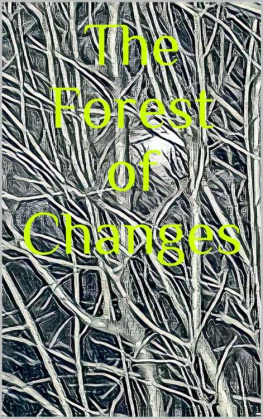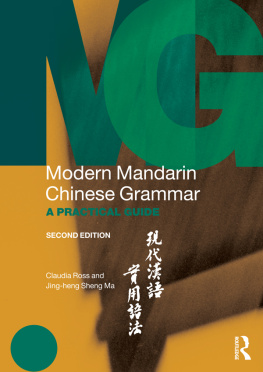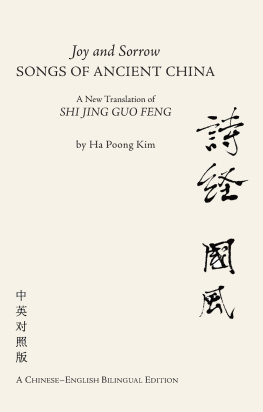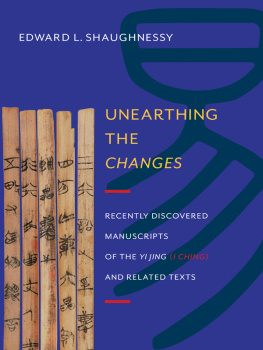Stephen R. Bokenkamp, Series Editor
Early Daoist Scriptures, by Stephen R. Bokenkamp
To Live as Long as Heaven and Earth: A Translation and Study of Ge Hongs Traditions of Divine Transcendents, by Robert Ford Campany
The Scripture on Great Peace: The Taiping jing and the Beginnings of Daoism, by Barbara Hendrischke
THE SCRIPTURE ON GREAT PEACE
The Taiping jing and the Beginnings of Daoism
Barbara Hendrischke

UNIVERSITY OF CALIFORNIA PRESS
University of California Press, one of the most distinguished university presses in the United States, enriches lives around the world by advancing scholarship in the humanities, social sciences, and natural sciences. Its activities are supported by the UC Press Foundation and by philanthropic contributions from individuals and institutions. For more information, visit www.ucpress.edu.
University of California Press
Berkeley and Los Angeles, California
University of California Press, Ltd.
London, England
2006 by The Regents of the University of California
First paper back Printing 2015
Library of Congress Cataloging-in-Publication Data
Tai ping jing. English
The scripture on great peace : the Taiping jing and the beginnings of Daoism / [translated by] Barbara Hendrischke.
p. cm(Daoist classics series)
Includes bibliographical references and index.
ISBN -13: 978-0-520-28628-3 (pbk : alk. paper)
ISBN -10: 0-520-24788-4 (cloth : alk. paper).
eISBN 9780520932920
1. Hendrischke, Barbara, 1940 II. Title. III. Title: Taiping jing and the beginning of Daoism.
BL1900.T22552E64 2007
299.51482dc222006018986
Manufactured in the United States of America
21 20 19 18 17 16 15
10 9 8 7 6 5 4 3 2 1
This book is printed on Natures Book, which contains 50% post-consumer waste and meets the minimum requirements of ANSI/NISO Z 39.481992 ( R 1997) ( Permanence of Paper ).
CONTENTS
Translation
Section 41.
Section 42.
Section 43.
Section 44.
Section 45.
Section 46.
Section 47.
Section 48.
Section 50.
Section 51.
Section 52.
Section 53.
Section 54.
Section 55.
Section 56.
Section 57.
Section 58.
Section 59.
Section 60.
Section 61.
Section 62.
Section 63.
Section 64.
Section 65.
Section 66.
PREFACE
The Taiping jing, or Scripture on Great Peace, sets forth views on social and political organization that are exceptional. There is nothing quite like them in other texts from ancient and early medieval China. The text proclaims that the traditional gap between the status of men and of women and also between leaders and followers must be narrowed. It also questions the reliability of scholarly traditions of reasoning and demands that the belief in heavens life-giving power be the sole principle of human action. It invites every concerned individual to enter into an ongoing dialogue with everyone else. Humankind, faced with the possibility of an imminent and violent end to the world brought about by the crimes that men have committed throughout history, is called upon to jointly mobilize its resources. There is therefore no doubt that this text has a lot to say, but it is not easy to access its message. Recent Chinese editions and Chinese-language translations of the text, however, have eliminated some of the problems inherent in accessing its message, and this translation is deeply indebted to them.
My involvement with the Scripture on Great Peace has been of some duration, and thanks are due to many colleagues and friends, and in particular to everyone in Daoist studies. From my perspective, Daologists across the world have shown themselves to be true followers of the dao, open, cooperative, and happy to share information and invite others to venture into their field. Special thanks are due to Christoph Harbsmeier for initiating this translation project. The librarians at the University of Sydneys Fisher Library and at the University of New South Wales have helped me access resources. Jon Kowallis and Lance Eccles have critically looked at passages of my work. Sue Wiles and Mary Severance have helped to improve its readability. Florian Reiter has been a source of encouragement, and Hans Hendrischke has provided generous organizational support. The comments of Gil Raz and the University of California Presss anonymous reader have been instructive and inspiring. Stephen Bokenkamp has patiently and with great wisdom made this publication possible.
CONVENTIONS
This translation of the Taiping jing follows the wording of the second edition of Wang Mings text, published in Beijing in 1979. His emendations of the original text found in the Daoist canon are followed unless otherwise specified; his punctuation is occasionally replaced by that used in more recent editions.
References to the text are by section and page number. Since Wang Mings edition is divided into chapters this might at first sight be confusing; however, this system is meant to help organize the text into meaningful units. The received text is divided into chapters (juan) , and each chapter is subdivided into several sections. Each section typically deals with a single topic, and the sections assembled in one chapter often have little in common. For this reason the chapter number is irrelevant for understanding and interpreting the scripture and is therefore ignored when quoting passages from the text.
In addition to section and page number, references to the text point to the layer to which a passage belongs (for more on this, see the Appendix). When no layer is mentioned the material is from layer A, that is, from those parts of the text where a Celestial Master talks to his disciples. When the passage referred to is not from the Taiping jing proper but from its Tang dynasty digest, the Taiping jing chao, this is so indicated: the word Chao is added to the reference, as is the respective part of the nine parts of the Chao that have been transmitted. There is a purpose to this rather cumbersome and space-consuming method of referring to the text. By the standards of ancient and early medieval texts the Taiping jing is a long scripture, and yet I have observed that its internal logic is remarkable. To locate all the passages referred to in their own environment might allow readers to share this observation and help them appreciate the texts coherence and argumentative insistence.
Introduction
The Taiping jing , or Scripture on Great Peace (hereafter TPJ), is an outsider with respect to Chinas tradition of great books. It differs in content and style from the texts that helped to create, nourish, and sustain the countrys central institutions and thereby became part of them. It was not until the twentieth century, when scholars began to articulate their skepticism about these institutions and search for alternative traditions, that the TPJ gained broader scholarly attention.










